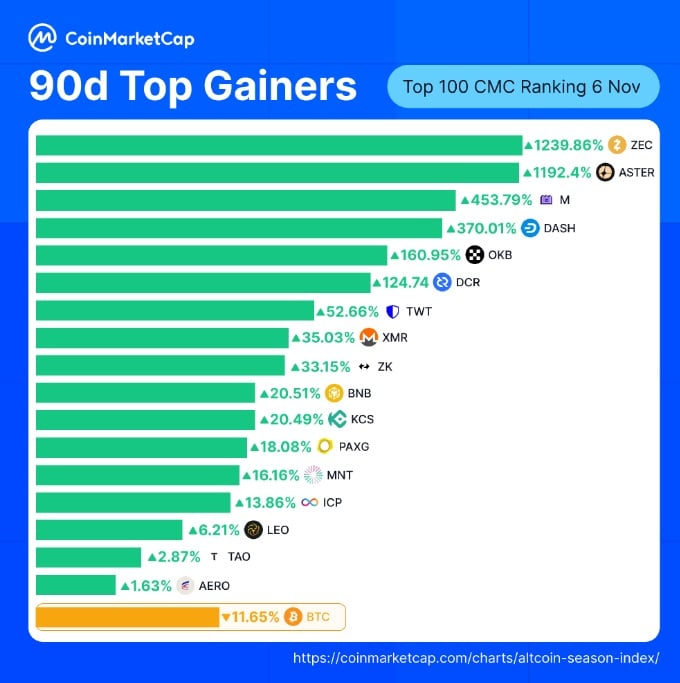Solana Stablecoin Market Cap Hits $14.1B in Q3 2025, Up 36.5%
Solana's stablecoin ecosystem experienced remarkable growth in Q3 2025, with total market capitalization surging 36.5% to reach $14.1 billion, solidifying its position as a major hub for dollar-pegged digital assets.
Explosive Quarter for Solana Stablecoins
The third quarter of 2025 marked a pivotal moment for Solana's stablecoin landscape. The 36.5% quarterly increase represents one of the strongest growth periods in the network's history, reflecting accelerating adoption across multiple use cases.
This growth trajectory significantly outpaced broader cryptocurrency market trends. While Bitcoin and Ethereum showed modest gains, Solana's stablecoin ecosystem demonstrated exceptional momentum driven by unique network advantages.
The $14.1 billion milestone positions Solana firmly among the top blockchain networks for stablecoin activity. Only Ethereum and Tron currently host larger stablecoin economies, highlighting Solana's rapid ascent in this critical sector.
Stablecoin market cap serves as a key indicator of blockchain network health and real-world utility. Unlike speculative tokens, stablecoins represent actual economic activity including payments, trading, and value storage.
Driving Forces Behind Growth
Several interconnected factors fueled Solana's stablecoin expansion during Q3. Network performance improvements, expanding DeFi applications, and strategic partnerships all contributed to accelerating adoption.
Solana's transaction speed and low costs create compelling advantages for stablecoin users. Transfers settle in seconds with fees typically under $0.01, making the network ideal for payments and frequent transactions.
The proliferation of decentralized finance protocols on Solana drove substantial stablecoin demand. Lending platforms, automated market makers, and yield farming opportunities all require stablecoin liquidity to function effectively.
Payment applications increasingly chose Solana for infrastructure. Merchants and payment processors recognized that combining stablecoin stability with Solana's performance enables superior user experiences compared to traditional payment rails.
Cross-border remittance services adopted Solana-based stablecoins for international transfers. The combination of instant settlement and minimal fees addresses longstanding pain points in global money movement.
USDC and USDT Dominance
Circle's USDC and Tether's USDT account for the vast majority of Solana's stablecoin market cap. Both issuers expanded their Solana presence significantly during Q3, responding to growing demand.
USDC on Solana benefited from Circle's strategic focus on the network. The company highlighted Solana's technical advantages and committed resources to expanding the ecosystem. Native USDC integration with major Solana applications drove usage growth.
Tether's USDT maintained strong presence despite newer competition. As the world's largest stablecoin by total market cap, USDT's availability on Solana provides essential liquidity for traders and institutions.
Smaller stablecoins including PayPal's PYUSD also contributed to ecosystem diversity. Multiple stablecoin options give users choice while ensuring no single point of failure threatens the broader ecosystem.
DeFi Protocol Contributions
Decentralized finance applications played crucial roles in absorbing stablecoin supply. Protocols like Marinade Finance, Jupiter, and Drift accumulated significant stablecoin deposits during Q3.
Automated market makers required deep stablecoin liquidity to facilitate efficient trading. Liquidity providers earned yields by depositing stablecoins into trading pools, creating virtuous cycles of capital attraction.
Lending protocols enabled users to earn interest on stablecoin deposits or borrow against other assets. These services provided utility for stablecoin holders while expanding overall ecosystem capital efficiency.
Yield aggregators optimized stablecoin returns across multiple protocols. These applications attracted users seeking passive income, further concentrating stablecoin capital within the Solana ecosystem.
Institutional Adoption Signals
The stablecoin growth reflected increasing institutional engagement with Solana. Trading firms, payment companies, and financial institutions expanded their Solana infrastructure during the quarter.
Market makers established larger stablecoin reserves on Solana to support trading operations. The network's speed and cost advantages made it attractive for high-frequency trading strategies requiring rapid position adjustments.
Payment processors integrated Solana stablecoins for merchant services. The ability to settle transactions instantly at negligible cost created competitive advantages over traditional payment networks.
Cryptocurrency exchanges increased their Solana stablecoin reserves to facilitate user deposits and withdrawals. Major platforms recognized user demand for Solana-based stablecoin options alongside Ethereum alternatives.
Regional Growth Patterns
Geographic analysis reveals uneven but significant adoption across global regions. Southeast Asia showed particularly strong growth, driven by remittance use cases and cryptocurrency trading activity.
Latin American users increasingly turned to Solana stablecoins for inflation hedging and international transactions. Countries experiencing currency instability saw accelerated adoption of dollar-denominated digital assets.
North American and European markets demonstrated steady institutional adoption. Regulated entities in these regions began exploring Solana infrastructure for compliant stablecoin applications.
Competitive Landscape Analysis
Solana's stablecoin growth occurred within an intensely competitive multi-chain environment. Ethereum maintains overwhelming dominance with over $100 billion in stablecoin market cap, while Tron hosts approximately $60 billion.
However, Solana's growth rate substantially exceeds larger competitors. The 36.5% quarterly increase suggests market share gains as users increasingly prioritize performance and cost efficiency.
Emerging Layer 2 solutions on Ethereum offer improved performance but still face friction compared to Solana's native efficiency. Cross-chain bridges introduce complexity and security risks that direct Solana usage avoids.
Alternative Layer 1 blockchains including Avalanche, Polygon, and BNB Chain compete for stablecoin activity. Each network offers distinct advantages, but Solana's combination of speed, cost, and ecosystem maturity creates strong competitive positioning.
Regulatory Considerations
Stablecoin regulatory developments significantly impact growth trajectories. Q3 2025 saw evolving frameworks in major jurisdictions affecting how issuers and platforms operate.
Circle and Tether both navigated changing compliance requirements while expanding on Solana. Clear regulatory pathways in certain jurisdictions enabled continued growth despite global uncertainty.
The Solana Foundation worked with policymakers to ensure network infrastructure meets emerging standards. Proactive engagement helps position Solana favorably as regulations crystallize.
Technical Infrastructure Improvements
Network upgrades during Q3 enhanced Solana's stablecoin capabilities. Performance optimizations increased transaction throughput while maintaining low latency and minimal fees.
Developer tools for stablecoin integration improved significantly. Simplified APIs and software development kits made building stablecoin applications more accessible for developers.
Security enhancements reduced risks associated with smart contract vulnerabilities. Auditing frameworks and best practices matured, increasing confidence in Solana-based stablecoin applications.
Future Growth Catalysts
Multiple factors could drive continued stablecoin expansion on Solana. Further institutional adoption, new use case development, and geographic expansion all represent potential growth vectors.
Payment innovation may accelerate adoption. Point-of-sale systems, e-commerce integrations, and mobile payment applications could bring stablecoins to mainstream consumers.
Regulatory clarity would unlock institutional capital currently sidelined by uncertainty. Clear frameworks enable conservative investors and traditional financial institutions to participate.
Risks and Challenges
Despite strong growth, several risks could impact Solana's stablecoin trajectory. Network outages, though less frequent, remain concerns that could erode confidence.
Competitive pressure from Ethereum Layer 2s and other high-performance chains may slow market share gains. Continuous innovation is necessary to maintain advantages.
Regulatory crackdowns on stablecoin issuers could constrain supply growth. Adverse policy developments in major markets would affect all blockchain networks including Solana.
Investment Implications
For cryptocurrency investors, Solana's stablecoin growth signals ecosystem health and real utility. Networks with growing stablecoin activity demonstrate genuine adoption beyond speculation.
SOL token holders may benefit indirectly from stablecoin expansion. Increased network activity generates transaction fees and attracts developers, potentially supporting long-term token value.
However, stablecoin growth alone doesn't guarantee investment returns. Investors should consider broader factors including technological development, competitive positioning, and market conditions.
Conclusion
Solana's 36.5% stablecoin market cap increase to $14.1 billion during Q3 2025 represents a significant milestone in blockchain adoption. The growth reflects fundamental advantages in speed, cost, and ecosystem development.
As stablecoins increasingly serve as digital dollars for global commerce, the infrastructure supporting them becomes critical. Solana's performance characteristics position it well for this evolving landscape.
Sustained growth will require continued technical excellence, regulatory navigation, and ecosystem expansion. The Q3 results suggest Solana is executing effectively across these dimensions, though challenges remain.
The stablecoin sector's growth on Solana demonstrates that utility-driven adoption can coexist with speculative cryptocurrency markets. Networks providing genuine value capture sustainable usage regardless of broader market sentiment.
You May Also Like

The Channel Factories We’ve Been Waiting For

Zcash Price Prediction: Can ZEC Surge Past $1,000 After 350% Rally?

